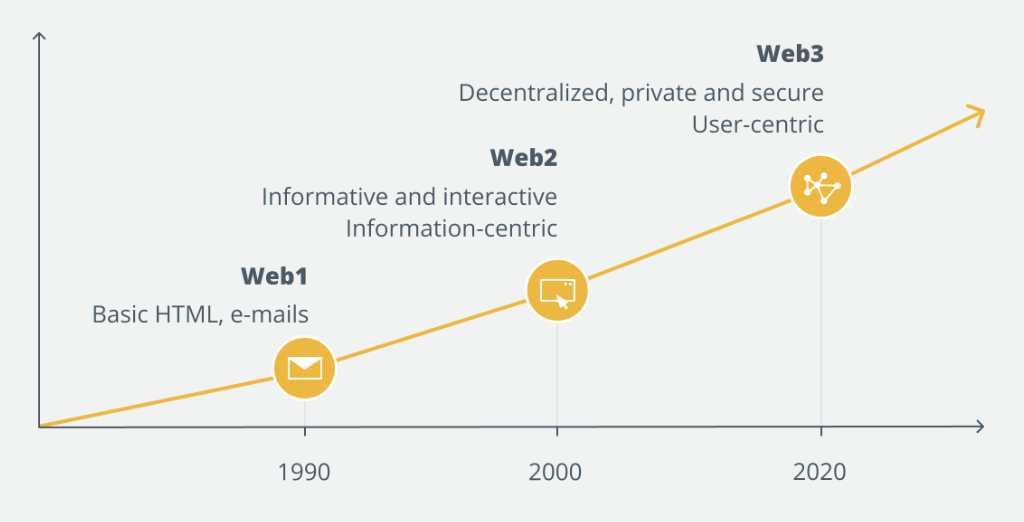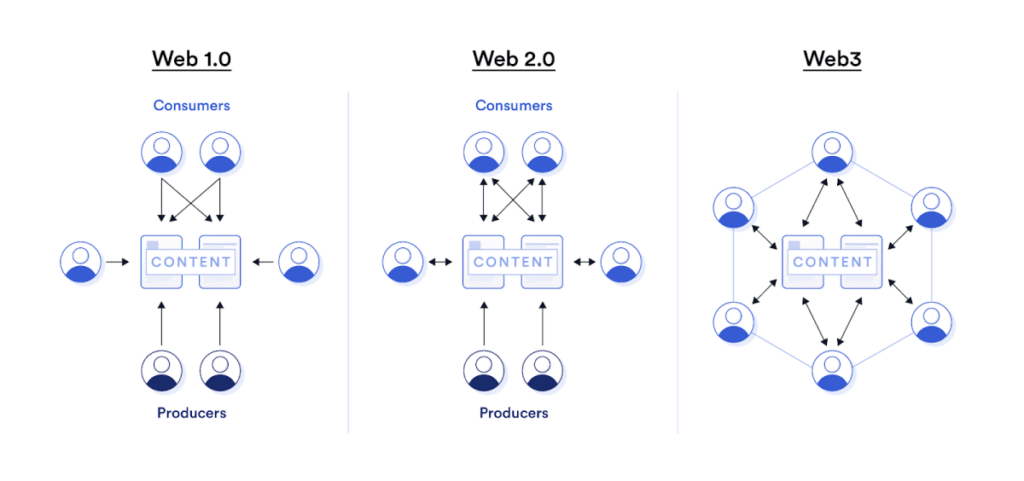Web3 community management is a crucial cornerstone for crypto projects. Traditional centralized platforms often dictate terms to a primarily passive user base. But in the landscape of web3, the power dynamics have shifted. Community members are often token holders or stakeholders directly impacting the project’s governance and success.
This guide closely examines how engaging your target audience, fostering community engagement, and utilizing blockchain-based decision-making can help build effective communities and projects.
Customer engagement: Web3’s unique advantages

Customer engagement in the web3 sphere differs from your typical online community or social media management. Here’s why:
- Decentralization: Unlike traditional platforms where users are just consumers, web3 technologies allow community members to participate in decision-making. Engaging with customers here means understanding their role in the ecosystem, not just viewing them as end-users.
- Smart contracts and tokenomics: In a web3 community, you’re not just dealing with likes, shares, and comments. Community members may also interact through smart contracts, participate in staking, or engage in liquidity mining.
- Transparent interactions: All actions are transparent and verifiable on the blockchain. This adds an element of trust but also necessitates a new level of transparency in community management.
- Educational aspect: The blockchain technology that underpins these communities is complex. A large part of engaging with customers involves educating them on how to interact with the platform effectively. Blogs, posts, webinars, and tutorials often form a core part of this education-centric engagement. A blockchain marketing agency might be a good addition to your efforts, as they can offer a wealth of experience and expertise.
- Building relationships for governance: Building relationships in a web3 community goes beyond customer satisfaction; it’s about stakeholder management. Your community members could vote on the next big feature or change in your project, and maintaining a healthy relationship with them is crucial for a harmonious ecosystem. With the new Google crypto ad policy in play, maintaining a personal and relatable relationship is more important than ever.
Understanding the basics of web3 technologies
Often referred to as the decentralized internet, web3 is designed to empower users and help strengthen imbalances in traditional web technologies.

While your marketing strategy may include SEO and social media management, for now — it’s vital to grasp that web3 technologies offer unique ways to engage with customers and community members.
Web3 vs. traditional web technologies
Traditional web technologies have served us well, but they are centralized, often leading to a lack of privacy and potential abuse of power. Here’s how web3 contrasts with its traditional counterpart:
- Data sovereignty: Unlike traditional settings where data is stored on centralized servers — web3 technologies allow community members to own and control their data.
- Token-based incentives: Web3 projects often include tokens to encourage active participation and build community relationships, which is missing in traditional online forums.
- Transparency and trust: With blockchain technology, every transaction and data change is transparent, creating trust among community members in traditional online forums.
Blockchain technology: the backbone of web3
Blockchain technology significantly impacts community management in web3 environments — offering various valuable features, including interconnectivity.
“Everything will be tokenized and connected by a blockchain one day”
Fred Ehrsam, Institutional adviser
- Immutable records: Once data is entered into the blockchain, it can’t be easily altered, providing security and trust vital for successful communities.
- Decentralization: Blockchain’s decentralized nature means that no single entity has complete control, aligning well with the web3 ethos of empowering individual community members.
- Smart contracts: These are automated, self-executing contracts with the terms directly written into code. They allow for trustless, transparent transactions, streamlining many community management tasks.
The importance of community in web3 projects

Traditional centralized models are giving way to decentralized, blockchain-based systems, reshaping the role of the community and engagement as a whole. Let’s delve into the unique aspects that make the community the cornerstone of any successful web3 project.
How communities fuel web3 technologies

Web3 technologies are inherently designed to be decentralized, a characteristic that makes engaging with customers and community members a foundational element. The following points underscore the symbiosis between community and web3 technologies:
- Decentralized governance: A strong community plays a pivotal role in the decentralized governance models often associated with blockchain technology. They can vote on project directions, propose changes, and contribute to development.
- Token economics: Community members often hold tokens that increase in value as the project succeeds. This token-based model aligns the interests of developers and community members, motivating everyone involved to contribute positively to the project’s growth.
- Social media management: With the rise of decentralized platforms, effective social media management becomes crucial in building an engaging community. It is a direct web3 communication channel where real-time feedback can be gathered and implemented.
The community adopts the technology and turns it into an integral part of any marketing strategy — aimed at a specific audience. They disseminate information, correct misconceptions, and help onboard new users, effectively acting as the fuel that powers the growth of web3 technologies.
Looking to build an engaged crypto community or harness existing communities? Get in touch with our web3 marketing experts here.
The role of community members
Understanding community members’ roles is essential for effective community management in web3 projects.
- Contributors: These individuals contribute code, content, or other resources. They are usually deeply involved and strongly understand the project’s goals and technology.
- Moderators: They oversee online community spaces, ensuring discussions remain productive and aligned with the project’s objectives.
- Investors and stakeholders: Often part of the initial coin offerings (ICOs) or token sales, they have a vested financial interest in the project’s success. Their role can be advisory, financial, or promotional.
Strong communities and project success
Strong communities are often the differentiating factor in the success or failure of web3 projects. They are the bedrock upon which these initiatives build their reputation, trust, and, ultimately, their value.
- Build relationships: A successful community is one where relationships are nurtured. These relationships form the basis for collaborations, partnerships, and other growth opportunities.
- Feedback: An active and engaged community is an invaluable source of feedback, which is crucial for development in the fast-paced world of blockchain-based projects.
- Sustainability: With a strong community, even when a project faces setbacks, the collective effort can help navigate challenges and adapt strategies for long-term sustainability.
Targeting your audience in the web3 space
When diving into the dynamic realm of web3 technologies, pinpointing your targeted audience is the cornerstone of building a successful community. Unlike traditional online communities, web3 communities often consist of a blend of developers, investors, and early adopters who are deeply engaged in blockchain technology.
Sponsored Sponsored- Demographic data: Collect and analyze data to understand who’s already engaging with your web3 projects. Are they developers, crypto enthusiasts, or perhaps investors looking for the next big thing? Demographic targeting is invaluable in crypto.
- Community surveys: Leverage the power of your existing online community to identify their needs, preferences, and expectations. Surveys can go a long way in understanding what community members value.
- Competitor analysis: Take note of other successful communities in the web3 space. What audiences are they targeting? This will not only help you identify potential community members but also enable you to find your unique value proposition.
By focusing on these elements, you’ll gain a more nuanced understanding of your targeted audience, ensuring that your community management in web3 aligns well with your members’ expectations.
Tailoring your marketing strategy for web3

Now that you’ve identified your target audience, it’s time to fine-tune your marketing strategy. Web3 projects require a somewhat different approach than traditional online ventures. This is mainly because blockchain-based platforms often involve tokens, smart contracts, and decentralized governance.
- Tokenomics: If your project includes a native token, craft compelling narratives and incentives around it. A token isn’t just a financial instrument; it’s a tool for engaging community members and building strong communities.
- Educational content: Create blog posts or video content that educates your audience on your project and web3 technologies. This not only positions you as a thought leader but also helps in engaging with customers who are new to the space.
- Decentralized tools: Use web3-native tools for community governance and rewards. Decentralized Autonomous Organizations, or DAOs, are increasingly popular for community management in web3.
The goal is not just to attract an audience but to build lasting relationships. A well-tailored web3 marketing strategy can be your roadmap to achieving just that.
SEO and social media management in web3
Web3 is not immune to the powerful reach of SEO and social media management; these tools could even be more crucial here due to the highly competitive nature of the space.
- Keyword planning: Your blog post topics should be meticulously researched to include targeted keywords, especially those that resonate with blockchain technology and web3 communities.
- Quality content: Focus on writing high-quality, in-depth content. Google’s algorithms increasingly favor content that provides comprehensive insights.
- Multi-channel approach: Don’t restrict yourself to just one platform. To have an engaging community, be present where your audience is — Twitter, Discord, and specialized blockchain forums, to name a few.
- Link-building: Effective link-building strategies are essential for visibility in the decentralized world of web3. Not only can well-placed backlinks drive traffic and credibility, but they also enhance your SEO efforts, helping you rank higher on search engines. They are also an excellent foundation for establishing a crypto affiliate marketing program.
When executed right, SEO and social media management can work wonders for your web3 community, transforming it from a group of sporadic users into a cohesive, engaging community that thrives on shared values and interests.
Implementing effective community management strategies
The formula for a successful community has evolved, transcending the boundaries of traditional social media management. The key to a thriving web3 community lies in how well you master a blend of strategic planning, operational excellence, and technological savviness.
Onboarding new members
Onboarding is a new member’s first impression of your web3 community, making it a crucial phase in building strong relationships. To effectively onboard new members:
- Provide clear guidelines: Offer a concise yet comprehensive set of rules and norms that govern community behavior. Make it easily accessible.
- Educational resources: Include guides or blog posts that familiarize newcomers with web3 technologies and how your community integrates them.
- Personalized welcome: Utilize smart contracts or bots to send automated yet personalized welcome messages to enhance the initial experience.
These steps don’t just apply to community members; they’re an invaluable part of your crypto marketing strategy. The better the onboarding experience, the easier it will be to start engaging with customers and building a targeted audience interested in your web3 projects.
Moderation and governance in blockchain-based communities
In blockchain technology, governance isn’t just a concept; it’s an integral part of the system. Moderation and governance in blockchain-based communities differ significantly from conventional online communities:
- Decentralized decision-making: Utilize DAOs to allow community members to propose and vote on initiatives.
- Transparency: Store moderation logs and governance decisions on the blockchain for greater accountability.
- Dispute resolution: Implement smart-contract-based methods for resolving disagreements without central authority.
While governance is a daunting challenge, mastering it will offer a unique selling proposition. By involving community members in decision-making, you create an engaging community that offers a sense of ownership, ensuring long-term sustainability.
Keeping community members engaged
Sustained engagement is the cornerstone of any successful community management in web3. Web3 communities usually demand a deeper, more substantive form of engagement than their traditional counterparts.
- Regular updates: Use blog posts and social media to inform the community about project milestones, updates, or any changes in governance.
- Interactive sessions: Conduct AMAs, webinars, or live code reviews to provide engaging educational content.
- Rewards and incentives: Implement tokenomics or gamification strategies to reward active participation.
Marketing strategy for your web3 community
Building a web3 community is a unique challenge that leverages traditional and digital marketing strategies and a deep understanding of blockchain technology.
Need a helping hand? Here are the six best web3 marketing agencies to help your crypto project and five need-to-know crypto advertising tips to help any web3 business get ahead.
You can use a wide array of crypto advertising products for your strategy. Here are some points to consider:
Content as a community driver
Your content strategy is the cornerstone of engaging with customers and community members alike. It’s not enough to simply post regular updates about your crypto projects; the content must be valuable, relevant, and intriguing to your targeted audience. Here are a few tips:
- Blog posts: A blog post can be a powerful tool to share in-depth knowledge, updates, or tutorials. Ensure your posts are SEO-optimized to attract more eyes to your web3 community.
- Social media management: Platforms like Twitter and Discord are indispensable for real-time engagement. Tweeting quick tips, news updates, or memes can foster an engaging community.
- Educational content: Web3 technologies can be complicated. Offering guides, FAQs, or webinars can build relationships by empowering your community members with knowledge.
Leveraging partnerships and collaborations
Strong communities often are a part of a larger ecosystem. Partnering with other web3 projects or blockchain-based organizations can drive unprecedented growth and engagement.
- Cross-promotions: Share each other’s content or create co-branded pieces that benefit both communities.
- Collaborative events: Joint webinars, AMA (Ask Me Anything) sessions, or hackathons can attract a broader audience while sharing the workload and benefits.
- Token swaps or airdrops: If your web3 community involves a token, consider a token swap or airdrop collaboration to incentivize community engagement.
Metrics to track for a successful community
In community management web3, specific metrics can give you deep insights into your strategies’ performance.
- Engagement rate: Likes, shares, comments—these are the vital signs of an online community. High levels of interaction indicate an engaging community.
- Retention rate: A successful community sees its members returning frequently. Monitor how many stay active over an extended period.
- ROI on collaborations: Always assess the impact of your partnerships. Are you gaining new members? Is there increased activity during collaborative events?
Challenges and solutions in web3 community management
The frontier of web3 technologies is an exciting but challenging landscape. Given blockchain-based ecosystems’ decentralized, fast-evolving nature, managing strong communities is complex.
Here, we’ll dive into some critical hurdles you’ll encounter alongside actionable solutions.
Sponsored SponsoredNavigating regulatory hurdles
- Understanding local and global laws: Web3 projects often have community members from around the globe, which complicates matters considerably when adhering to local and international laws.
- Transparency in tokenomics: Regulations often require precise information on token distributions, use cases, etc.
Navigating the regulatory environment is one of the first challenges in web3 community management.
A successful community is built on a trust foundation, including compliance with applicable laws. Always seek legal advice tailored to your project’s targeted audience and jurisdictions. Crypto regulation is complex, but transparency in your blog posts and across all your social media management channels will go a long way in establishing credibility.
Ensuring security and trust

Ensuring security and trust is not just a technical issue; it’s a critical component of your marketing strategy. Blockchain technology is still relatively new, and bad actors abound. Utilize multi-signature wallets, employ smart contracts with in-built security measures, and even consider community-led auditing to ensure the platform is secure.
Keep your online community informed about these safety features. The more you can build relationships based on mutual trust, the more likely your community will be to engage long-term.
Sustaining an engaging community over time
- Regular updates and roadmaps: Keep your community informed about upcoming developments and features.
- Interactive events and AMAs: Engage directly with your community through interactive events such as AMA sessions.
Sustaining an engaging community over time is the most challenging aspect of management in web3. Freshness of content is key — in your overall approach to community interaction. Leveraging regular updates, interactive events, and clear roadmaps will keep community members invested in the long-term vision of your web3 projects. Periodic AMAs can act as a valuable two-way channel: they not only keep the community updated but also provide management with community sentiment and feedback.
Future trends in web3 community management
The dynamic landscape of web3 technologies continually evolves, presenting unprecedented challenges and opportunities in community management. As we move deeper into this decentralized paradigm, a few key trends stand out that could define the future of web3 community management.
The role of DAOs in community management
Decentralized autonomous organizations (DAOs) are poised to revolutionize how we think about engaging with customers and community members. DAOs are blockchain-based entities that operate without centralized control, guided by smart contracts and consensus among their members. This offers a fascinating layer to our traditional understanding of community management.
- Community-driven decision-making: In a DAO, decision-making is often democratic, allowing community members to have a tangible impact on the direction of web3 projects.
- Financial incentives: Tokenomics integrated within DAOs provide a groundbreaking way to monetize a successful community.
- Transparency: All decisions, transactions, and votes are recorded on the blockchain, fostering trust and engagement among community members.
Understanding the power of DAOs can significantly enhance your marketing strategy by creating more engaging community experiences.
Emerging tools and platforms for management in web3
While traditional online community platforms offer various tools for social media management, the web3 space is brimming with innovative solutions that offer unprecedented capabilities.
- NFTs for community engagement: Imagine engaging community members by rewarding their contributions with unique, blockchain-based tokens with intrinsic value. The potential of NFTs in social media and marketing is still largely unrealized, particularly by web3 companies.
- Decentralized social networks: Platforms like Mastodon are starting to integrate blockchain technology to allow for a more democratized control and monetization of content. Web3 communication networks are also on the rise.
- Decentralized identity management: Protecting and empowering the individual user through blockchain-based identity systems ensures stronger communities.
These tools are not just theoretical concepts; they are rapidly coming to fruition and will become indispensable in crafting a targeted audience for your web3 community.
The long-term vision for web3 communities
As we look toward the future, it’s essential to envision the long-term goals for web3 community engagement. In the web3 realm, communities won’t operate in isolation. They will be part of a larger, interconnected network of blockchain technologies and platforms. Tokenomics and community-driven revenue models will make it more sustainable for communities to operate long-term. Meanwhile,hyper-personalization is key. Leveraging smart contracts and AI, the future will allow for highly personalized experiences without sacrificing privacy or security.
By adopting these future trends into your management strategy, you’ll build a successful community and stay ahead of the curve in leveraging decentralized technologies for web3 community engagement.
Looking for support with marketing or advertising your crypto business? Our deidated team of experts can help supercharge your strategy and support essenital community building and management. Find out more here.

